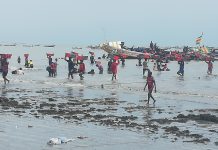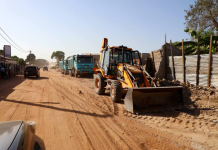By: Sheikh Alkinky Sanyang
“Climate change induced damage to human and economic development  has become a great concern most especially along the coastal areas of The Gambia. The combined effects of sea level rise and changes in upstream river discharge, erosion of coastal embankments and changes to natural sediment dynamics pose a serious threat to the natural resource base and livelihood opportunities of coastal communities. In addition to recurrent and rapid onset of extreme events like flash flooding, The Gambia’s coastal zone is being confronted with a range of creeping climate risks, such as increasing salinity level trends in coastal freshwater resources, growing drainage congestions, dynamic changes in coastal sediment dynamics and morphology, and a decline in the functioning of protective ecosystems like mangroves”.
This is an excerpt from the background information given by Malick Gai, UNDP/GEF Least Developed Country-Fund (GEF LCD-Fund) project`s Monitoring and Evaluation Officer, during a press briefing recently held at the NEA`s Kanifing office before leading the TAT members on a field trip. He posited that the ultimate objective of this four year project on Enhancing Resilience of Vulnerable Coastal Areas and Communities to Climate Change is to reduce Gambia’s vulnerability to sea-level rise and associated impacts of climate change.
This press clinic was on the foothill of a field visit to all the identified project sites by the Technical Advisory Team (TAT) of the project, in an effort to have first hand information which will immensely help them in their decision makings. He said the TAT is the technical arm of the project and their advice is very critical.
According to Gai, the project that is expected to run till 2017 is to achieve the following three key outputs; (i) policies, institutions and individuals mandated to manage coastal areas strengthened, (ii) vulnerability of coastal investments to climate risks reduced through the design, construction and maintenance of coastal protection measures and (iii) rural livelihoods in the coastal zone enhanced and protected from impacts of climate change.
At the end of the field trip, Malick Gai expressed satisfaction on the outcome of the field trip which he described as successful. Furthermore, he revealed that vulnerable coastal communities to climate change-induced risk and with salt intrusion including Bintang in the West Coast, Darsilami and Illiasa in the North Bank, and Tendaba in the Lower River Regions were visited by TAT members.]]>
has become a great concern most especially along the coastal areas of The Gambia. The combined effects of sea level rise and changes in upstream river discharge, erosion of coastal embankments and changes to natural sediment dynamics pose a serious threat to the natural resource base and livelihood opportunities of coastal communities. In addition to recurrent and rapid onset of extreme events like flash flooding, The Gambia’s coastal zone is being confronted with a range of creeping climate risks, such as increasing salinity level trends in coastal freshwater resources, growing drainage congestions, dynamic changes in coastal sediment dynamics and morphology, and a decline in the functioning of protective ecosystems like mangroves”.
This is an excerpt from the background information given by Malick Gai, UNDP/GEF Least Developed Country-Fund (GEF LCD-Fund) project`s Monitoring and Evaluation Officer, during a press briefing recently held at the NEA`s Kanifing office before leading the TAT members on a field trip. He posited that the ultimate objective of this four year project on Enhancing Resilience of Vulnerable Coastal Areas and Communities to Climate Change is to reduce Gambia’s vulnerability to sea-level rise and associated impacts of climate change.
This press clinic was on the foothill of a field visit to all the identified project sites by the Technical Advisory Team (TAT) of the project, in an effort to have first hand information which will immensely help them in their decision makings. He said the TAT is the technical arm of the project and their advice is very critical.
According to Gai, the project that is expected to run till 2017 is to achieve the following three key outputs; (i) policies, institutions and individuals mandated to manage coastal areas strengthened, (ii) vulnerability of coastal investments to climate risks reduced through the design, construction and maintenance of coastal protection measures and (iii) rural livelihoods in the coastal zone enhanced and protected from impacts of climate change.
At the end of the field trip, Malick Gai expressed satisfaction on the outcome of the field trip which he described as successful. Furthermore, he revealed that vulnerable coastal communities to climate change-induced risk and with salt intrusion including Bintang in the West Coast, Darsilami and Illiasa in the North Bank, and Tendaba in the Lower River Regions were visited by TAT members.]]>




















